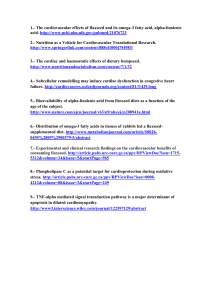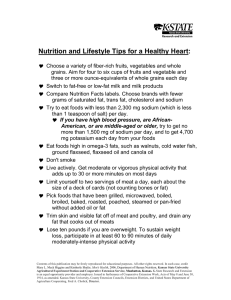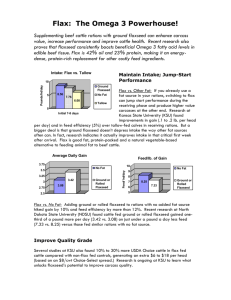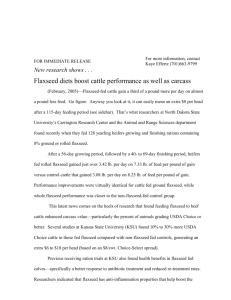FLAXSEED Th.e Nutritional Benefits of Inside: •
advertisement
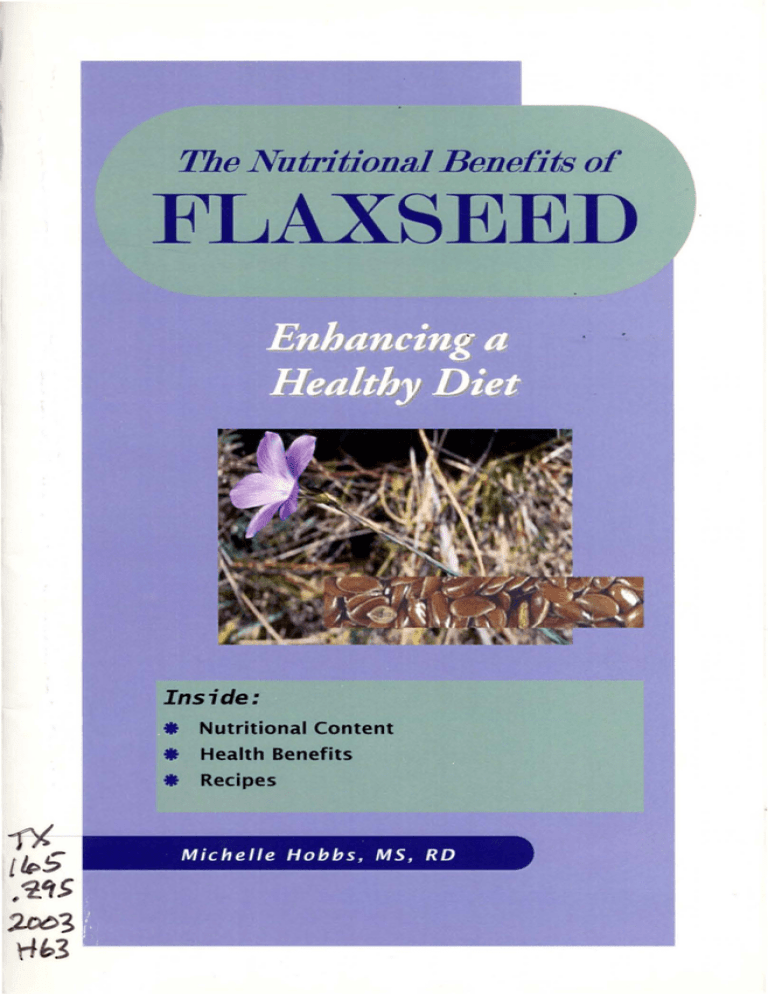
Th.e Nutritional Benefits of FLAXSEED Inside: • Nutritional Content • Health Benefits • Recipes Michelle Hobbs, MS, RD The Nut1itiona1 BonofJts of FLAXSEED Enhancing a Healthy Diet Michelle Hobbs, MS, RD First Edition Michelle Hobbs is a registered dietitian and a member of the American Dietetic Association. Acknowledgements The author wishes to express sincere appreciation to Cindy Heiss, Carol Koprowski and Alyce Blackmon for their assistance in the preparation and editing of this project. First Edition, 200.3 Michelle llobb!., MS, RD Thanks also to the members of California State University, Northridge and St. John's Regional Medical Center for their support and valuable input. The information presented here is intended solely as educational and not as medical advice. Always consult your physician . This booklet is dedicated to my mother, who introduced me to the simple joy ofhealthy food. Table of Contents Grown readily in cool climates and dry so~l, flaxseed flowers bloom in beautiful · shades of red, yellow, white or blue. Introduction 8 What is Flaxseed? 9 Reported Health Benefits 10 Nutritional Content of Flaxseed 14 General Use and Preparation 16 Storing Flaxseed 17 Safety and Regulatory Status 18 Recipes 19 Summary 28 References 30 Appendix 34 The Nutritional Benefits ofFLAXSEED 7 Introduction Nothing can take the place of a healthy diet. There is no magic pill, vitamin, powder or any other substance that can completely match the power of a well-balanced diet which includes all the basic food groups and their nutrients. In addition, most nutrients are best used by the body in food form, versus an extract or supplement. Scientists are not quite sure why many nutrients consumed in food form perform more optimally than when isolated, and the effect of whole foods is still being studied. The US Dietary Guidelines and Food Guide Pyramid are guides to good nutrition for the general, healthy public over age two. The Dietary Guidelines recommend the following: Aim for a healthy weight-be physically active each day. Let the Food Guide Pyramid guide your food choices. Choose a variety ofgrains daily, especially whole grains. Choose a variety offruits and vegetables daily. Keep food safe to eat. Choose a diet that is low in saturated fat and calories and moderate in total fat. Choose beverage and foods that limit your intake ofsugars. Choose and prepare foods with less salt. ffyou drink alcoholic beverages, do so in moderation. The USDA Food Guide Pyramid recommends eating about 50-60% of your total calories daily as complex carbohydfates, 10-15% as protein, and about 25-30% of calories as fat. In addition, the American Heart Association recommends limiting saturated fat intake to 7-10 % of total fat intake per day. People today are looking for ways to improve their health. This booklet is designed to introduce an easily accessible food called flax that is rich in healthy fats and fibers, vitamins, minerals and phytonutrients. According to scientific studies, adding flaxseed to a healthy diet may help reduce the risk of certain diseases such as heart disease and some cancers. What a simple way to enhance nutrition! What is Flaxseed? Flaxseeds are small, brown, oval-shaped seeds not unlike sesame seeds, though darker in color. They have a tough o uter hull and are chewy inside. There are many varieties in prod uction today. Most have a similar nutty flavor and aroma. Flaxseed is currently used mainly in breads and bakery products in small amounts to add texture and flavor. Historical documentation suggests flaxseed has been used as a food supplement since about 3,000 B.C. in Babylon. Later, Hippocrates reportedly wrote about its use to relieve abdominal pain. In 8th century A.O., Charlemagne passed laws regarding the consumption for the health of his people! By 1875, European settlers began to seed the North American west. Canada is now the largest flax exporter in the world. Flaxseed (also known as linseed) is used for its oils in creating coatings to protect wood. Its fibers are used to produce doth (linen). Flaxseed has long been used as livestock feed to maintain a healthy coat and skin and to improve digestion. Today, people are beginning to use flax in their diet on a daily basis to reap its benefits. While some people use the flax oil capsules, they may not be getting all the beneficial constituents like dietary fiber and lignans that the whole seed has to offer. In addition, flaxseed in its seed form is much less expensive than oil capsules. The Nutritional Benefits ofFI.AXSEED 9 Reported Health Benefits of Flaxseed Diet and nutrition play a large role in overall health. Potential healthy constituents of flaxseed include omega-3 fatty acids, soluble and insoluble fiber, phytonutrients called lignans, and vitamins and minerals. These constituents may not be found in flax oil capsules in levels that equal those present in the whole seed. Omega-3 Fatty Acids Flaxseed is rich in polyunsaturated fats called omega-3 fatty acids. We know that too much fat in the diet is not good for us, and the American Heart Association recommends 30-35% of total calories a day from fat, with a majority from polyunsaturated and monounsaturated fats. Omega-3 and some omega-6 fats cannot be made by the body and must come from food sources. Omega-6 fats are found in many foods while omega-3 is harder to find and is present in some plants and in cold water fish. There is some evidence that people do not consume enough omega-3 fats for the optimal balance of omega-3 and omega-6 fats . Fat balance is important for the body to func. tion opti~ally to help ,reduce risks of heart disease and infla~mation. Current ratios of omega-6 fat to omega-3 fat m the modern diet of the United States are thought to be about 10-25 to 1.. This may be off balance. A more desirable goal is a ratio of 4-5 to 1. Recommended amounts of omega-3 fats to achieve this goal are about 0.75 to 1.1 grams per day to balance out the ratio of omega-3's to omega-G's. Flax is 41 % oil, over half of which is omega-3 type and at least two times more than any other food! Reported Health Benefits of Flaxseed Fiber Insoluble fiber helps regulate bowel movements and soluble fiber has been shown to help improve cholesterol levels. Flaxseed contains both of these kinds of fiber, especially the soluble type. Lignans Lignans are phytonutrients (substances derived from plants with nutritional properties) that act in the body the way some natural bodily substances do. Lignans are also referred to as phytoestrogens because they have been shown to mimic the effects of some hormones in the body in favorable ways. Flaxseed is quite high in phytoestrogens. Vitamins and Minerals Flaxseed is rich in certain vitamins and minerals such as folate, calcium, magnesium, phosphorous, potassium, selenium and iron. The Nutritional Benefits ofFLAXSEED · 11 Reported Health Benefits of Flaxseed Reported Health Benefits ofFlaxseed Heart Disease and Flaxseed Other Potential Benefits Soluble fiber from oats is well-known for its ability to improve blood cholesterol levels. In addition, omega-3 fatty acids, such as those found in coldwater fish, may decrease blood cholesterol levels. Rich in both soluble fiber and omega-3 fatty acids, flaxseed also provides lignans, substances believed to provide additional help reducing the risk of heart disease. Studies show an average of 11-16% total cholesterol reduction in people who consumed 30-50 grams of flaxseed per day for four weeks. Omega-3 fatty acids are reported to help lower LDL ("bad") cholesterol and blood triglycerides, and increase HDL ("good") cholesterol levels. Up to 4 grams of omega-3's have been recommended for people with high triglycerides. There is additional evidence regarding flaxseed's potential ability to benefit the immune system, help control blood sugar levels in diabetics, improve dry skin conditions as well as reduce the painful effects of inflammation in different types of arthritis. Cancer and Flaxseed Currently, the American Institute for Cancer Research is studying flaxseed as a potential cancer-fighting food due to its high lignan content. Lignans are converted in the intestine to ho_rmoµe-like subst~ces that may be able to reduce absorption of and rid the body of potential cancer-causing agents. R~searchers are also studying the effect of omega-3 fatty acids on cancer risk reduction. The Nutritional Benefits ofFLAXSEED 13 Nutritional Content of Flaxseed The suggested intake of Omega-3 fatty acid intake to achieve optimal fatty acid balance is minimum 0.7-1.lgrams per day. This can be accomplished with many foods, but flaxseed has more omega-3 fatty acids than most other foods . Also, it contains up to 800 times more lignans than any other plant food! FLAXSEED Per serving: 4 milled Tablespoons (l ounce or about 26-28 grams) Total Calories Protein 120 6.0 g 9.0 g Total Fat Og Saturated Monounsaturated 2.2 g Polyunsaturated 6.8 g Omega-3 fatty acids 4.6 g Omega-6 fatty acids 2.2 g Dietary Fiber *8.0 g *The American Diet etic Associat ion recom mends 25-35 (maxim um of 40) grams df fiber per day. Flaxseed ca n provi de a significant amount of your daily fiber at 8 grams per serving. Note: Omega-3 fatty acids in excessive amounts may have blood-thinning properties that may cause unwanted side effects and interact with certain medications. Keep consumption oftotal fat to a moderate amount (Less than or equal to 30% oftotal calories per day) and check with a doctor first, to see ifadding flaxseed to your diet is right for you. Nutritional Content of Flaxseed OMEGA-3 FATTY ACID CONTENT In Grams Per 100 g Food Approximately 3 Tablespoons Flaxseed Walnuts (English) Salmon Pecans Tuna Halibut Cod Soybeans Tofu Broccoli (raw) Sunflower seeds 18.30 9.08 2.22 0.98 0.93 0.55 0.47 0.35 0.30 0.13 0.07 of whole flaxseed has more omega-3 fatty acids than 3 112 ounces cooked salmon or 1/4 cup walnuts! Source: ESRA Food Processor database Flaxseed is rich in vitamins and minerals like calcium for strong bones and Jolie acid and iron for healthy blood and energy. LIGNAN content In Micrograms Per 100 g Food Flaxseed Dried Seaweed Legumes Cereals Vegetables Fruit 52,679 900 562 359 144 84 Source: T hompson LU. Flaxseed in Human Nutrition. 1995: AO CS Press, Champaign, IL p. 219 The Nutritional Benefits ofFLAXSEED 15 General Use a nd Preparation IN ORDER TO GET ALL THE GREAT BENEFITS OF FLAXSEED, IT IS IMPORTANT TO CRACK OPEN THE TOUGH HULL BY GRINDING OR MILLING THE SEEDS TO A COARSE MEAL. THIS CAN BE DONE BY PULSING Storing Flaxseed Flaxseed, whether whole or milled, is highly resistant to rancidity, making it easy to store since it is so stable. While best stored in the refrigerator, flax can be stored well at room temperature of about 68-72 degrees F. SEEDS A FEW TIMES IN A COFFEE BEAN GRINDER OR A BLENDER. FOR FRESHNESS, STORE WHOLE FLAXSEED FOR UP TO According to research, flaxseed becomes effective at levels of intake of about 25-50 grams of flax per day. This is equal to about 4-6 tablespoons of milled seed. Flax is versatile and can be added to or baked in a variety foods. It is also quite heat stable and whether it is used raw, baked, cooked or any other way, you still get all the healthy benefits. When adding flaxseed to your diet, you may want to start slowly and work up to the full amount since flax is so high in dietary fiber. If you are not used to consuming a lot of fiber in your usual diet, your stomach may need a transition period to build tolerance to higher daily intakes of dietary fiber. In addition, 'i t is important to increase your fluid intake as you eat more fiber. ONE YEAR IN YOUR REFRIGERATOR, OR 6 MONTHS AT ROOM TEMPERATURE. STORE MILLED FLAXSEED FOR UP TO 6 MONTHS IN THE REFRIGERATOR, OR 3 MONTHS AT ROOM TEMPERATURE. Remember to keep flaxseed, especially milled, in a bag or container that seals well to maintain freshness and limit exposure to air, which can cause the flaxseed to become stale or hasten deterioration. Also, baking or cooking with flaxseed does not significantly reduce the benefits of flaxseed's healthy nutrients. Store baked items as usual. The Nutritional Benefits ofFLAXSEED 17 Safety and Regulatory Status Flaxseed is considered safe for human consumption based on its long history of safe use and studies confirm amounts up to 50 grams per day do not cause adverse effects in generally healthy people. The Food and Drug Association (FDA) lists specific constituents naturally found in flaxseed, such as solin oil, linolenic and linoleic fatty acids, and lignans as Generally Recognized as Safe (GRAS). While flax has been petitioned and amended as safe for human consumption, it has not yet been added to the GRAS list, nor have regulations been established that define its use. Flaxseed may not be suitable for persons with certain conditions warranting restriction of whole grains or seeds, such as kidney disease. Flaxseed is gluten-free and will not likely negatively affect persons with celiac disease. Potential effects of flaxseed include blood-thinning. Check with your doctor if you are taking blood-thinning medications or if you plan to have surgery. RECIPES Banana Pecan Flax Bread Fruit & Flax Breakfast Shake Oatmeal Flax Cookies Italian Vegetable Salad Roasted Vegetable-Barley Soup Chicken Wild Rice Casserole Carrot Flax Cake Note: if you are following a sodium-restricted diet, you may omit the salt from the following recipes and substitute low-sodium broth or soup. In addition, low-sodium baking soda is usually available in health food stores. The Nutritional Benefits ofFLAXSEED 19 Oatmeal Flax Cookies A traditional favorite with an extra wholesome boost. Provides approximately 8 grams of flaxseed and 2.7 grams Omega-3 fats per 2 cookies. l . Preheat oven to 3 50 degrees F. Beat together sugars and canola oil , add egg and vanilla until blended. 2. Combine flour , baking soda , cinnamon , oats and flax . Add to egg and sugar mixture . Mix well and stir in raisins and nuts . 3. Drop by heaping teaspoon onto un-greased cookie sheet . Bake ·l 0-25 minutes until golden brown . Cool and serve . Makes about 24 cookies. Serving size 2 cookies. per serving: 370 7.6 g 60 g 5.9 g 29% Total Fat Saturated fat Vitamin A Vitamin C Simple and flavorful. Substitute vegetables you have on hand. Each serving contains about 8.1 grams flaxseed and 1.8 grams Omega-3s. l /2 cups raw cauliflower florets (bite size pieces) cup broccoli florets l cup white onions, chopped 2 cups fresh button mushrooms , cleaned 2 large , raw, green bell peppers 2 cups red, ripe, cherry tomatoes l cup fat free Italian salad dressing l /2 cup flaxseed, milled l /4 cup liquid egg substitute l /4 cup canola oil l cup brown sugar, packed l /2 cup wh ite granulated sugar l tsp . vanilla extract 3 cups dry, old -fashioned oats 3/4 cup All-purpose white flour 3/4 cup fla x seed , milled l tsp . baking soda l tsp . ground cinnamon l cup seedless raisins l /2 cup dried Englis h walnuts , chopped Nutritional analysis Calories Protein Carbohydrates Dietary Fiber % Calories from fat Italian Vegetable Salad 12 .6 g 1.2 g 14 RE 0 .7 mg l . Wash and cut vegetables into bite-sized pieces . Combine together and pour dressing over vegetables . Blend in milled flaxseed . 2. Cover; marinate in refrigerator several hours . Makes about 8 servings. Nutritional analysis Calories Protein Carbohydrates Dietary Fiber % Calories from fat per serving: l 07 4.8g l5g 5.8g 31 % Total Fat Saturated fat Vitamin A Vitamin C The Nutritional Benefits ofFIAXSEED 4 .0 g 0.5 g 85 RE 73 .6 mg 23 Chicken Wild Rice Casserole Roasted Vegetable-Barley Soup Casseroles are a great place to add flaxseed since it blends so well and adds a nutty flavor. Each serving of this dish provides around 11 grams flaxseed and 2.5 grams Omega-3 fats. Heart-healthy and chock full of phytonutrients. Freeze some for later! About 5.4 grams flaxseed and 2.5 grams Omega-3 fatty acids. 3 lb fresh red tomatoes , seeded/chopped 1 lb white on ion, chopped 1/4 tsp salt 1 1/2 tsp . crushed garlic 1/8 tsp black pepper 1 lb raw carrots , sliced 8 oz can kidney beans 1/2 cup flaxseed, milled 1 T . olive oil 3/4 cup pearl barley 2 quarts chicken broth 2 cups sliced, canned black olives 1/4 cup chopped , fresh parsley 1. In a large bowl mix tomatoes , onions , garlic , carrots and olive oil. Transfer to sheet pan and roast in a 450 degree F. oven for 45 minutes . Stir occasionally . Transfer mixture to a large stock pot . 2. Add barley and broth to vegetable mixture . Heat to a boil. Reduce heat . Cover. Simmer until barley is tender , about 45° minutes . . 3. Add beans, milled flaxseed , olives and parsley. 4. Adjust seasoning with salt and pepper. . 4. Serve in shallow bowls with a slice or wedge of focacc1a or hearty crusted bread . Makes about 12 servings . Nutritional analysis Calories Protein Carbohydrates Dietary Fiber % Calories from fat per serving: 21 8 9 .3 g 31 g 8.5 g 29% . Total Fat Saturated fat Vitamin A Vitamin C 7 .5 1 .0 526 30 .0 g g RE mg 2 cups chicken broth 1 cup dry wild rice 2 T. olive oil 1/2 medium onion, chopped 1/2 tsp. salt 1/2 cup green bell pepper, chopped 1 cup sliced mushrooms 1/8 tsp. thyme 3 roasted chicken breasts, chopped 6 ounce can cream of asparagus soup 2 garlic cloves , crushed 1/2 cup flaxseed, milled 1/2 cup sliced almonds 1/4 tsp . Black pepper 1. Prepare rice according to package directions using broth as liquid ; set aside . 2. Place olive oil in a heavy saucepan over low heat. Saute onion in oil until golden. Add green pepper and mushrooms . Continue cooking until tender. 3. Combine condensed soup , cooked rice , sauteed vegetables , chopped chicken breasts and remaining ingredients . 4. Pour into lightly greased 2-quart casserole. Sprinkle with sliced almonds . Cover and bake at 350 degrees F. for 35 minutes . Makes 6 servings . Nutritional analysis Calories Protein Carbohydrates Dietary Fiber % Calories from fat per serving: 433 37 .5 g 34 g 6.9 g 3 5% Total Fat 16.9 g Saturated fat 2.6 g Vitamin A 23 RE Vitamin C 1 3. 5 mg The Nutritional Benefits ofFLAXSEED 25 A word on adding flaxseed . to recipes. • • Carrot Flax Cake Who says dessert can't be good for you? How about a treat with 11 or so grams of flaxseed and 3.2 grams Omega-3 fatty acids per serving. 4 cups grated, raw carrots 2 cups white granulated sugar 8 oz can crushed pineapple with juice l /2 cup canola oil l /4 cup liquid egg substitute l /4 cup orange juice 2 tsp. vanilla extract l 3/4 cup all-purpose flour l /2 tsp. salt 2 tsp. ground cinnamon 2 tsp . Baking soda l cup flaxseed, milled 9 oz fat-free cream cheese 6 T. powdered confectioner's sugar 3 T. nonfat milk l. Preheat oven to 375 degrees F. Coat a 9 x 13-inch baking pan with vegetable cooking spray; set aside. In large bowl combine carrots , sugar, pineapple, oil, egg substitute, orange juice and vanilla; stir to blend thoroughly . 2. Add flour, baking soda, salt, milled flaxseed, cinnamon; mix completely . 3. Spread batter in prepared pan. Bake about 45 minutes until pick inserted into center comes out clean . Cool on rack . 4 . Whip cream cheese, milk and powdered sugar. Frost cake. Cut into 3 x 3 l /4 inch pieces . Makes l 2 servings. Nutritional analysis per serving: 407 8.7 g 63 g 5.7 g 31 % Calories Protein Carbohydrates Dietary Fiber % Calories from fat Total Fat 14.2 Saturated fat l .3 Vitamin A 1103.0 Vitamin C 6.9 g g RE mg Although a generally healthy amount of flaxseed to eat each day is about 4-6 tablespoons, this does not mean you must consume it all at one time, in or on one food or just one meal. If you like, spread out the amount over the day in different ways. Get accustomed to adding flaxseed to your baked . products and on meals. There are many foods to which flax will easily blend and add texture and flavor. You can add it to just about anything: Cereal Juice Yogurt Casseroles Tacos Soups Salads Stews Sauces and dressings Dips Hot cereals Tuna, chicken or egg salad Pancakes, waffles or muffins Cakes and cookies Chili or even atop pizza! The possibilities are endless ... use your imagination! Also, try substituting 1/3 of the oil or flour in recipes with flaxseed. If you do, you may need to reduce baking time a few minutes. The Nutritional Benefits ofFLAXSEED 27 Summary The connection between nutrition and health is an important one. The health benefits associated with flaxseed consumption make it a valuable complement to your daily diet Flax is easy to use and imparts a good flavor and texture to foods. As a rich source of essential fats, fiber and plane compounds, flaxseed is a good addition because of its potential health benefits to reduce risks of heart disease and cancer, and contributes to overall good health. Consuming flax in its humble, ground food form is the best and safest way to get all the great benefits flax has to offer. The Nutritional Benefits ofFLAXSEED 29 References Alonso L, Marcos ML, Blanco JG, et al. Anaphylaxis caused by linseed (flaxseed) intake. J A l/ergy Clin lmmunol. I 996;98:469-70. References Hambly R, Rumney C, Fletcher J. Effects of high- and low-risk di ets on gut microflora-associated biomarkers of colon cancer in human flora-associated rats. Nutr and Cancer. l 997 ;27(3) :250-55 . Alpers L, Sawyer-Morse M. Eating quality of banana nut muffins and oatmeal cookies made with ground flaxseed. J Am Diet Assoc. 1996 August;96(8):794-97. Hutchins A, Martini M, Olson B, et al. Flaxseed consumption influences endogenous hormone concentrations in postmenopausal women. Nutr and Cancer. 200 I ;39( I ):58-65. Annussek G, Flaxseed. Gale Encyc lopedia of Alternative Medicine. 2001: 45658. James M, Gibson R, Cleland L. Dietary polyunsaturated fatty ac ids and inflammatory mediator production . Am J Clin Nutr. 2000;7.I (supple):343S-8S. · Babu U, Mitchell G, Wiesenfeld P, et al. Nutritional and hematological impact of dietary flaxseed and defatted flaxseed meal in rats. Int J Food Sci Nutr. 2000;5 l: I 09-17. Jenkins D, Kendall C, Vigdin E, et al. Health aspects of partially defatted flaxseed, including effects on serum lipids, oxidative measures, and ex vivo androgen and progestin activity: a controlled crossover trial. Am J Clin Nutr. 1999:69 (3):395 -402 . Bolt H, Janning P, Michna H, Degen G. Comparative assessment of endocrine modulators with oestrogenic activity: definition of a hygiene-based margin of safety (HBMOS) for xeno-oestrogens against the backgro und of european developments. Arch Toxicol. 200 I ;74:649-62. Brzezinski A, Debi A. Phytoestrogens: the " natural" selective estrogen receptor modulators? Eur J Obst Gyn Repr Biol. 1999;85 :4 7-51. Cunnane S, Hamadeh M, Leide A et al. Nutritional attributes of traditional flaxseed in healthy yo ung adults. Am J Clin Nutr. 1995;6 1:62-8. Demark-Wahnefried W, Price D, Polascik T, Robertson C, et al. Pilot study of dietary fat restriction and flaxseed supplementation in men with prostate cancer before su rgery: exploring the effects on hormonal levels, prostate-specific antigen, and histopathologic features. Adult Urology. 2001 ;58( 1):47-52. ESHA Food Processo r Software, version 7.5 Ferretti A, Flanagan V. Antithromboxane activity of dietary alpha-linolenic acid: a pilot study. Prostaglandins, Leukotrienes and Essential Fatty Acids. 1996;54 (6):45 1-55. Haggans C, Travelli E, Thomas W, et al. The effect of fl axseed and wheat bran consumption on urinary estrogen metabo lites in premenopausal women. Cancer, Epidemiology, Biomarkers & Prevention. 2000;9:719-25. Hall D. Nutritional influences on estrogen metabolism. App Nutr Sci Reports. 2001 Jan ;451 l-17. Ketts D, Yuan Y, Wijewickreme A, Thompson L. Antioxidant activity of the fl axseed lignan secoisolariciresinol diglycoside and its mammailian lignan metabolites enterodiol and enterolactone. Molecular and Cellular Biochem. I 999;202 :91-100. Kuiper G, Lemmen G, Carlsson BO, et al. Interaction of estrogenic chemicals and phytoestrogens with estrogen receptor [beta] . Endocrinology. 1998; 139 ( I 0):4252-62 . Lewi s NM, Seburg S, Flanagan N. Enriched eggs as a source of n-3 polyun saturated fatty acids for humans. Poultry Science. 2000;79 :97 1-4. Mantzioris E, Cleland L, Gibson R, et al. Biochemical effects of a diet containing foods enriched with n-3 fatty acids. Am J Clin Nutr. 2000;72:42-8. Mantzioris E, James M, Gibson R, Cleland L. Dietary substitution with an alphalinoleni c acid-rich vegetable oil increases eicosapentaenoic acid concentrations in tissues. Am J Cl/in Nutr. 1994;59: 1304-9. Meagher L, Beecher G, Flanagan V, Li B. Isolation and characterization of the lignans, isolari ciresinol and pinoresinol, in flaxseed meal. J Agric Good Chem. I 999;47:3173-80. Meilahn E , De Stavo la B, Allen OS, et al. Do urinary estrogen metabolites predict breast cancer? Guernsey Ill cohort fo llow-up. Brit J Cancer. 1998;78 : 125055 . The Nutritional Benefits ofFLAXSEED 31 References Muir A, Westcott N. Quantitation of the lignan secoisolariciresinol diglucoside in baked goods containing flax seed or flax meal. J Agric Food Chem. 2000;48:4048-52. Nesbitt P, Lam Y, Thompson L. Human metabolism of mammalian lignan precursors in raw and processed flaxseed. Am J Clin Nutr. I 999;69:549-55. Nordstom D, Honkanen V, Nasu Y, et al. Alpha-linolenic acid in the treatment of rheumatoid arthritis-a double-blind, placebo-controlled and randomized study: flaxseed oil vs. safflower seed. Rheumatol Int. 1995; 14:231 -34. Obermyer W, Musser S, Betz C, et al. Chemical studies ofphytoestrogens and related compounds in dietary supplements: flax and chaparral. PSEBM. I 995 ;37:6-12. References Talom R, Judd SA, Mcintosh D, McNeill JR. High flaxseed (linseed) diet restores endothelial function in the mesenteric arterial bed of spontaneously hypertensive rats. Life Sci. 1999;64( 14): 1415-25. Thompson L, Richard S, Cheung F, Kenaschuk E, Obermeyer W. Variability in anticancer lignan levels in flaxseed. Nutr and Cancer. 1997;27(1 ):26-30. Thompson L, Richard S, Orcheson L, Seidl M. Flasxeed and its lignan and oil components reduce mammary tumor growth at a late stage of carcinogenesis. Carcinogenesis. 1996; 17(6): 1373-76. · Thompson L, Richard S, Orcheson L, Seidl M. Flasxeed and its lignan and oil components reduce mammary tumor growth at a late stage of carcinogenesis. Carcinogenesis. 1996; 17(6): 1373-76. Pattanaik U, Prasad K. Oxygen free radicals and endotoxic shock: effect of flaxseed. J Cardiovasc Pharmacol Therapeut. 1998;3(4):305-18. Tou J, Thompson L. Exposure to flaxseed or its lignan component during different developmental stages influences rat mammary gland structures. Carcinogenesis. 1999;20(9): 1831-35. Price S, Wilson L. Pathophysiology. S'h ed, 1995; Mosby (Boston): 111-1 6, 98688. Website: www.flaxcouncil.com Reifen R, Arnita! H, Blank M, Sklan D, et al. Linseed oil suppresses the antibeta-2-glycoprotein- I in experimental antiphospholipid syndrome. J Autoimmunity. 2000;15:381-5. Yager JD, Lei hr JG, Molecular mechanisms of estrogen carcinogensis. Ann Rev Pharmacol Toxicol. I 996;36:203-32. Rickard S, Yvonne Y, Chen J, et al. Dose effects of flax seed and its lignan on Nmethyl-N-nitrosourea-induced mammary tumorigenesis in rats. Nu tr and Cancer. 1999;35( I ):50-7. Serraino M, Thompson L. The effect of flaxseed su pplementation on the initiation and promotional stages of mammary tumorigenesis. Nutr and Cancer. 1992; 17(2): 153-58. Serraino M, Thompson L. The effect of flaxseed supplementation on early risk markers for mammary carcinogenesis. Cancer Letters. 1991 ;60: 135-42 . Stoll BA. Adiposity as a risk determinant for postmenopausal breast cancer. Int J Obes Re/at Metab Disord. 2000 May;24(5) :527-33. The Nutritional Benefits ofFLAXSEED 33 Appendix Conversions: 1 pound = 454 grams or 16 ounces 1 gram = 0.035 ounces 1 ounce = r28 grams 1 cup whole flaxseed = r l80 grams 1 cup milled flaxseed , packed = r 2 T. milled flaxseed :r 1 oz. milled flaxseed = r28 grams 130-150 grams 13 grams
